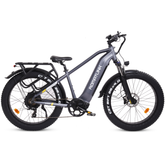Best Electric Bike Buying Guide - Consumer Reports
Electric bikes, or e-bikes, are bicycles that have an electric motor that can assist the rider with pedaling or provide full throttle power without pedaling. Electric bikes are becoming more popular as a way of commuting, exercising, or exploring nature. They can help riders overcome hills, headwinds, or long distances with less effort and more fun. However, not all electric bikes are the same.
There are different types, features, and prices to consider when buying an electric bike. In this article, we will provide some guidance on how to choose the best electric bike for your needs and budget, based on the ratings and reviews from Consumer Reports.
Types of Electric Bikes
Classification Based on Class
Electric bikes are categorized into different classes based on their motor type, speed limit, and pedal assistance. In the US, there are three main classes of electric bikes:
Class 1 e-bike
This is a pedal-assist e-bike that only provides assistance when you pedal, and stops assisting when you reach 20 mph. The motor power is limited to 750W. This type of e-bike is great for bike lanes, bike paths, roads, or anywhere you would take a traditional bike. It is also the most widely accepted type of e-bike in terms of regulations and access.
Class 2 e-bike
This is a throttle-assist e-bike that provides a boost without pedaling, and stops assisting at 20 mph. The motor power is also limited to 750W. This type of e-bike is good for riders who want more control over their speed and acceleration, or who have difficulty pedaling due to injury or disability. However, this type of e-bike may not be allowed on some trails or bike paths that prohibit throttle use.
Class 3 e-bike
This is a pedal-assist e-bike that provides assistance up to 28 mph on pedal-assist mode, and up to 20 mph on throttle mode (if equipped). The motor power is also limited to 750W. This type of e-bike is ideal for riders who want to go faster and further than other e-bikes. It is also suitable for commuting or touring on roads or highways. However, this type of e-bike may require a license, registration, or insurance in some states or localities.
Classification Based on Design and Purpose
In addition to these classes, there are also other types of electric bikes based on their design and purpose. For example:
Folding e-bike
This is an e-bike that can be folded into a compact size for easy storage and transport. It is perfect for riders who have limited space at home or work, or who want to combine their e-bike ride with public transportation or car travel. Folding e-bikes usually have smaller wheels and frames than regular e-bikes, which may affect their stability and comfort.
Mountain e-bike
This is an e-bike that is designed for off-road riding on rough terrain. It usually has a robust frame, suspension forks, wide tires, and powerful brakes. It may also have a higher motor power than other e-bikes to handle steep climbs and descents. Mountain e-bikes can enhance the fun and adventure of trail riding by allowing riders to tackle more challenging routes and obstacles.
Factors You Need to Condiser When Choose the Right Ebike
When buying an electric bike, there are several factors to consider besides the type and class of the e-bike. Here are some tips to help you find the best electric bike for your needs:
Type
The type of electric bike determines how much assistance you get from the motor and how fast you can go. There are three classes of electric bikes: class 1 (pedal assist up to 20 mph), class 2 (throttle assist up to 20 mph), and class 3 (pedal assist up to 28 mph). You should choose a type that matches your riding style and local regulations.
Budget
Electric bikes can range from a few hundred dollars to several thousand dollars depending on their quality, features, and brand. You should set a realistic budget based on how much you are willing and able to spend on an electric bike. You should also factor in the cost of maintenance, accessories, and battery replacement over time.
The price depends on the quality, performance, and features of the electric bike. Generally, you get what you pay for, but you should also look for the best value for your money. You should compare different models and brands of electric bikes based on their specifications, reviews, and ratings. You should also test ride some electric bikes before buying one to see how they feel and fit you. You should choose an electric bike that suits your needs, style, and personality.
Riding style
You should think about how you plan to use your electric bike and what kind of riding experience you want.
For example, do you want to use it for commuting, leisure, fitness, or adventure? Do you prefer a smooth and comfortable ride or a fast and thrilling ride? Do you need a lot of assistance or just a little boost? These questions can help you narrow down your options based on the performance, features, and comfort of different electric bikes.
Terrain
You should also consider the terrain you will be riding on most often. Different terrains may require different types of e-bikes, tires, gears, and suspension. For example, if you will be riding on paved roads or bike paths, you can choose a class 1 or 2 e-bike with smooth tires and a simple suspension. If you will be riding on gravel roads or dirt trails, you may want a class 1 or 3 e-bike with knobby tires and a more advanced suspension. If you will be riding on steep hills or mountains, you may need a class 3 e-bike with a powerful motor and a wide range of gears.
Battery
The battery is one of the most important components of an electric bike, as it determines how far and how long you can ride with assistance. The battery capacity is measured in watt-hours (Wh), which is the product of the voltage (V) and the amp-hours (Ah). The higher the Wh, the more range you can get from your e-bike. However, the actual range also depends on other factors such as your riding speed, terrain, rider weight, and pedal assistance level. On average, electric bikes can travel between 25 - 45 miles (~40-72 KMs) on a single charge1. However, some electric bikes can offer more than 100 miles (~160 KMs) of range with larger batteries2.
You should choose a battery size that matches your expected riding distance and frequency. You should also consider the charging time and lifespan of the battery. A typical electric bike battery will take 2-6 hours to fully recharge3, and can last for 500-1000 charge cycles before losing significant capacity4. You should follow the manufacturer's instructions on how to charge and maintain your battery properly to extend its life and performance.
Features
Electric bikes come with various features that can enhance your riding comfort, safety, and convenience. Some of the common features are:
Display: This is a screen that shows you important information such as your speed, distance, battery level, pedal assistance level, and more. Some displays are simple LCDs that are easy to read in daylight, while others are more advanced touchscreens that can connect to your smartphone or GPS via Bluetooth or Wi-Fi.
Lights: These are essential for riding at night or in low-light conditions. They help you see the road ahead and be seen by other road users. Some electric bikes have integrated lights that are powered by the battery, while others have separate lights that need their own batteries or chargers.
Brakes: These are crucial for stopping safely and smoothly. There are two main types of brakes on electric bikes: rim brakes and disc brakes. Rim brakes use pads that squeeze against the rims of the wheels to slow down the bike. They are cheaper and easier to maintain than disc brakes, but they are less effective in wet or muddy conditions. Disc brakes use rotors that are attached to the hubs of the wheels and calipers that clamp onto them to stop the bike. They are more expensive and harder to maintain than rim brakes, but they offer better braking performance and modulation in all weather conditions.
Gears: These allow you to adjust the resistance of your pedaling to suit different speeds and terrains. There are two main types of gears on electric bikes: derailleur gears and hub gears. Derailleur gears use a chain that moves across different sprockets on the rear wheel and front crankset to change gears. They offer a wide range of gears and are easy to repair, but they require frequent cleaning and adjustment. Hub gears use an internal mechanism that changes gears inside the hub of the rear wheel. They offer a limited range of gears and are harder to repair, but they are more durable and require less maintenance.
Warranty: This is a guarantee from the manufacturer or seller that covers any defects or damages to your electric bike within a certain period of time. A good warranty can give you peace of mind and save you money on repairs or replacements in case something goes wrong with your electric bike. You should check what is covered by the warranty, how long it lasts, and how to claim it before buying an electric bike.
Two Ebikes Recommended
Romatlink Dolphin
The Romatlink Dolphin Fat Tire Folding Electric Bicycle is one of the best e-bikes to consider. It features a powerful 48V750W motor and is equipped with a Samsung 30A battery that provides ample power for long-distance riding. In assist mode, you can ride up to 100 miles, and in pure electric mode, up to 80 miles. The bike has a convenient folding design, making it easy to store and transport. With a top speed of 25mph, this e-bike is perfect for commuting or leisurely weekend rides.
Dolphin Step-thru Full Suspension Folding Fat Tire Ebike | 750W, 48V 30Ah
Romatlink Rhino
Another great option from Romatlink is the Rhino All-Terrain Electric Bicycle. With its aluminum alloy frame and 26-inch aluminum shoulder and aluminum leg shock-absorbing fork, the Rhino is built to handle rough terrain. The 48V750W brushless Hall motor provides ample power and can climb slopes up to 40 degrees. The Samsung 48V 20AH battery ensures you can ride up to 80 miles on assist mode, and up to 55 miles in pure electric mode. The Shimano 7-speed gearbox and hydraulic disc brake system provide a smooth, safe riding experience.
Rhino All Terrain Fat Tire Electric bike | Hydraulic Brake | 750W, 48V 20Ah
Conclusion
Electric bikes are a great way to enjoy cycling with less effort and more fun. They can help you commute faster, exercise better, or explore further than traditional bikes. However, not all electric bikes are created equal. There are different types, features, and prices to consider your budget and preferences. Electric bikes vary widely in price, from a few hundred to several thousand dollars.
I hope this guide helps you find your ideal electric bike. Happy riding!






